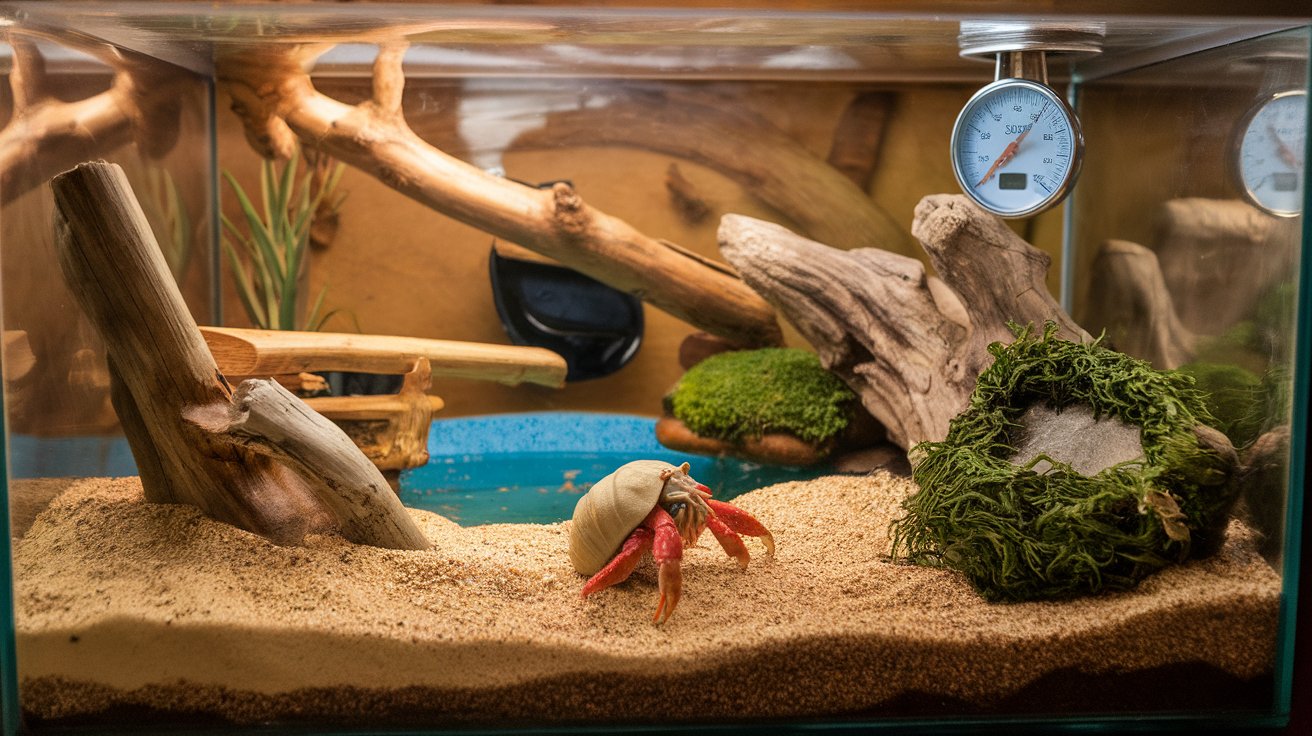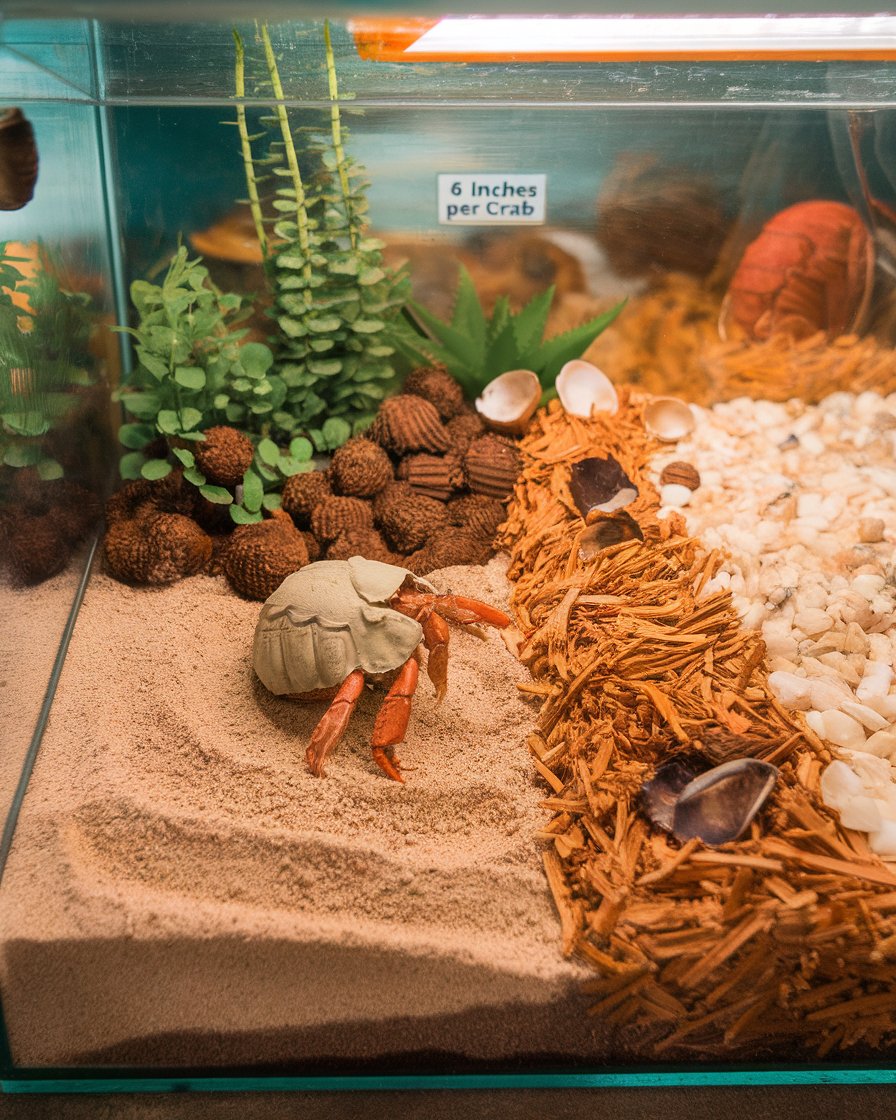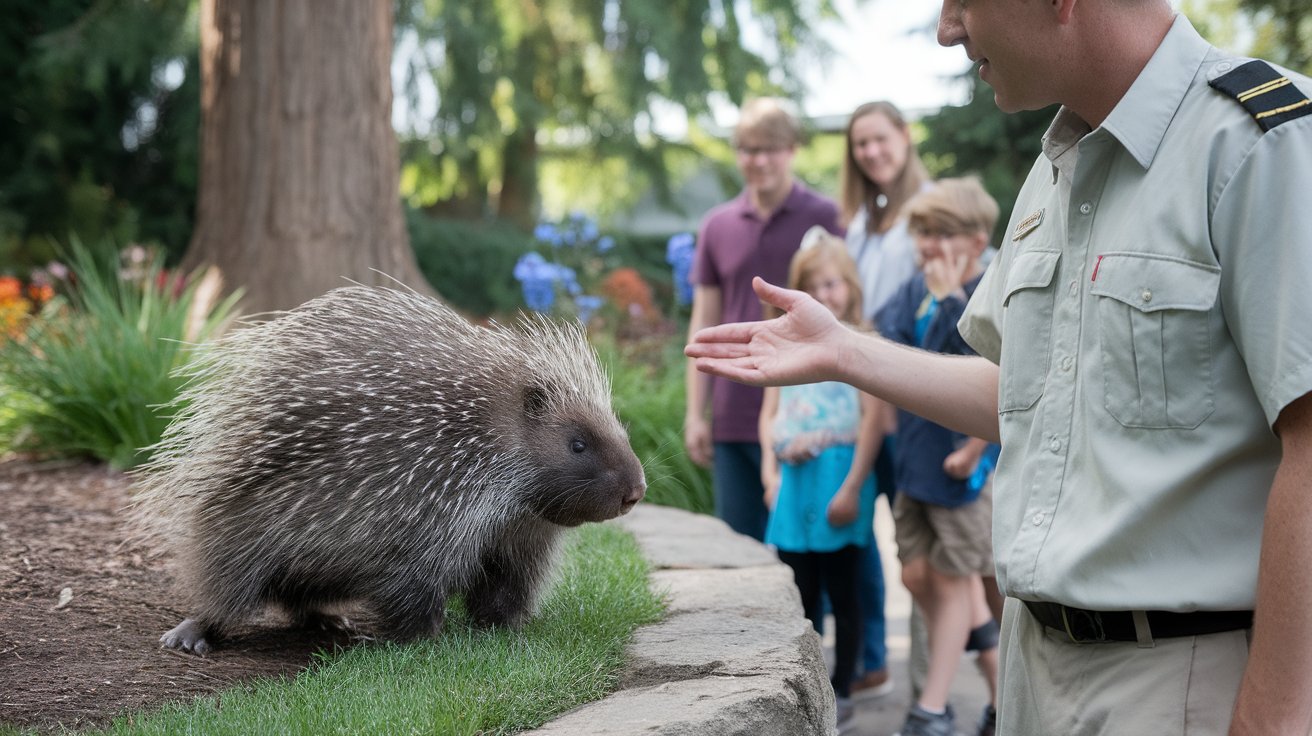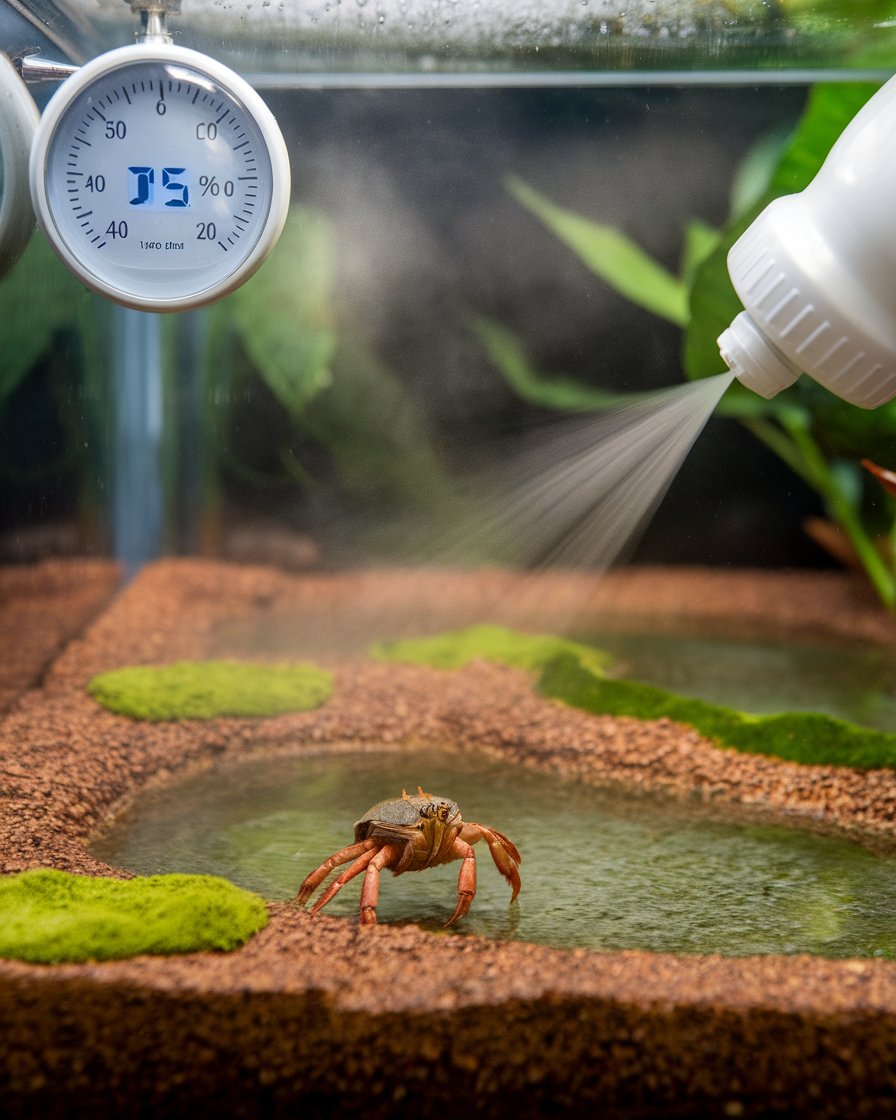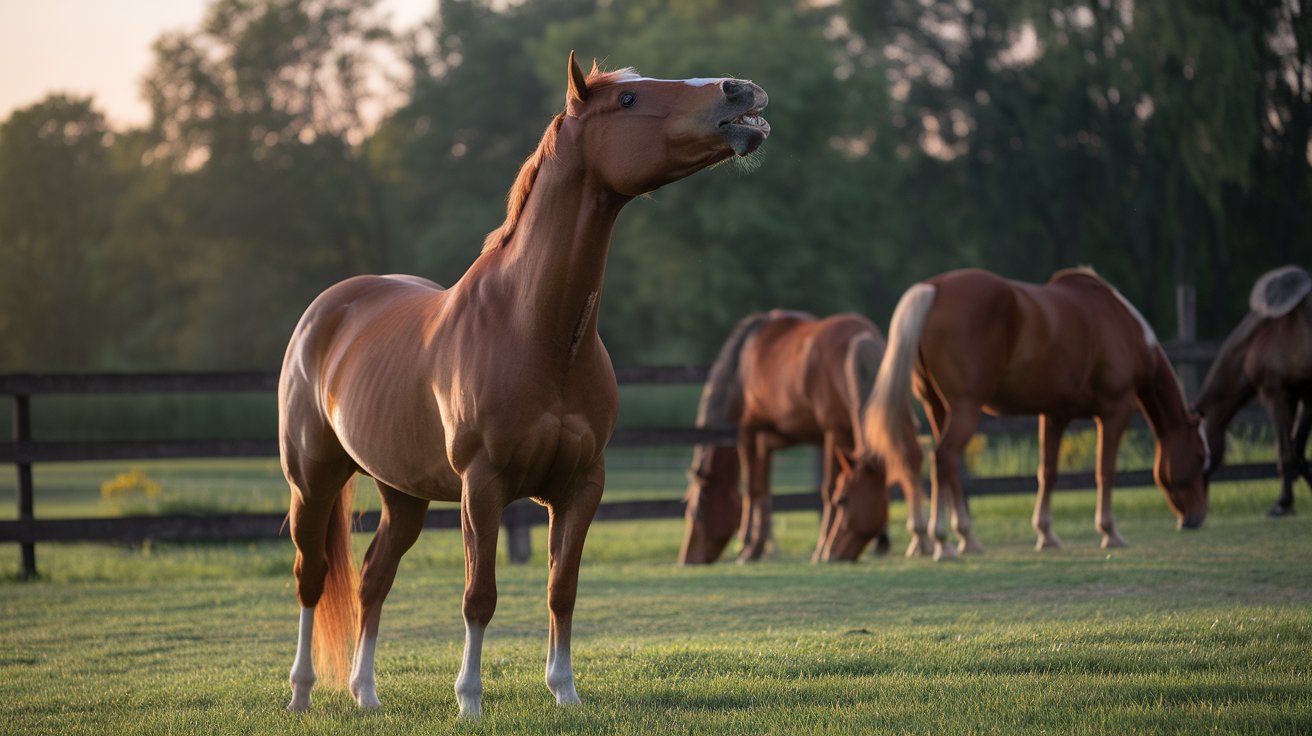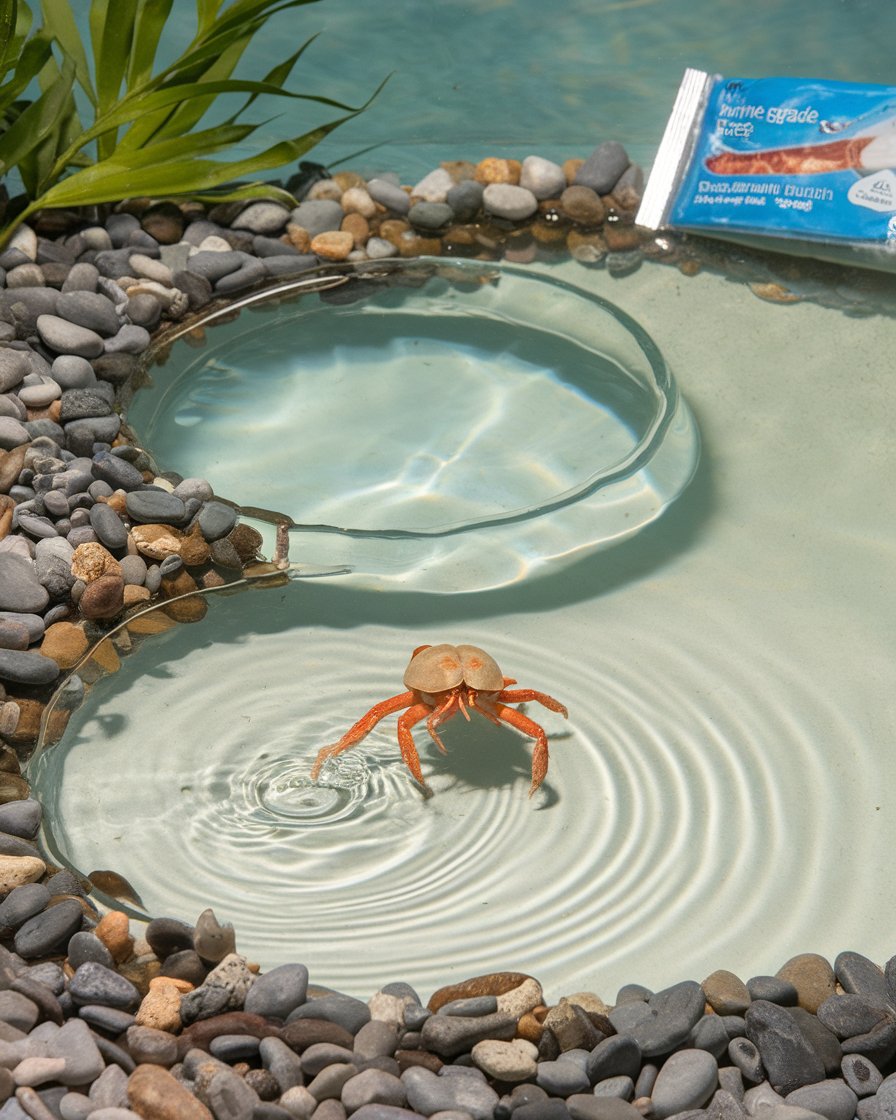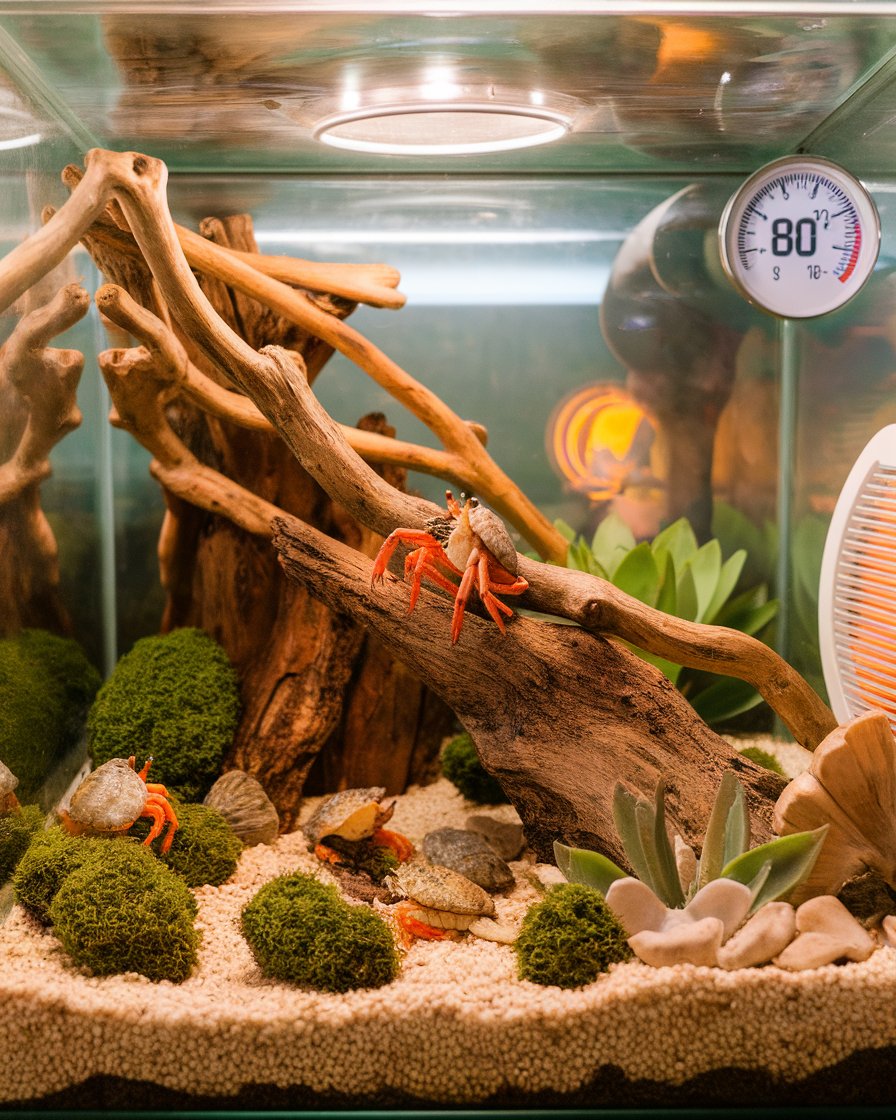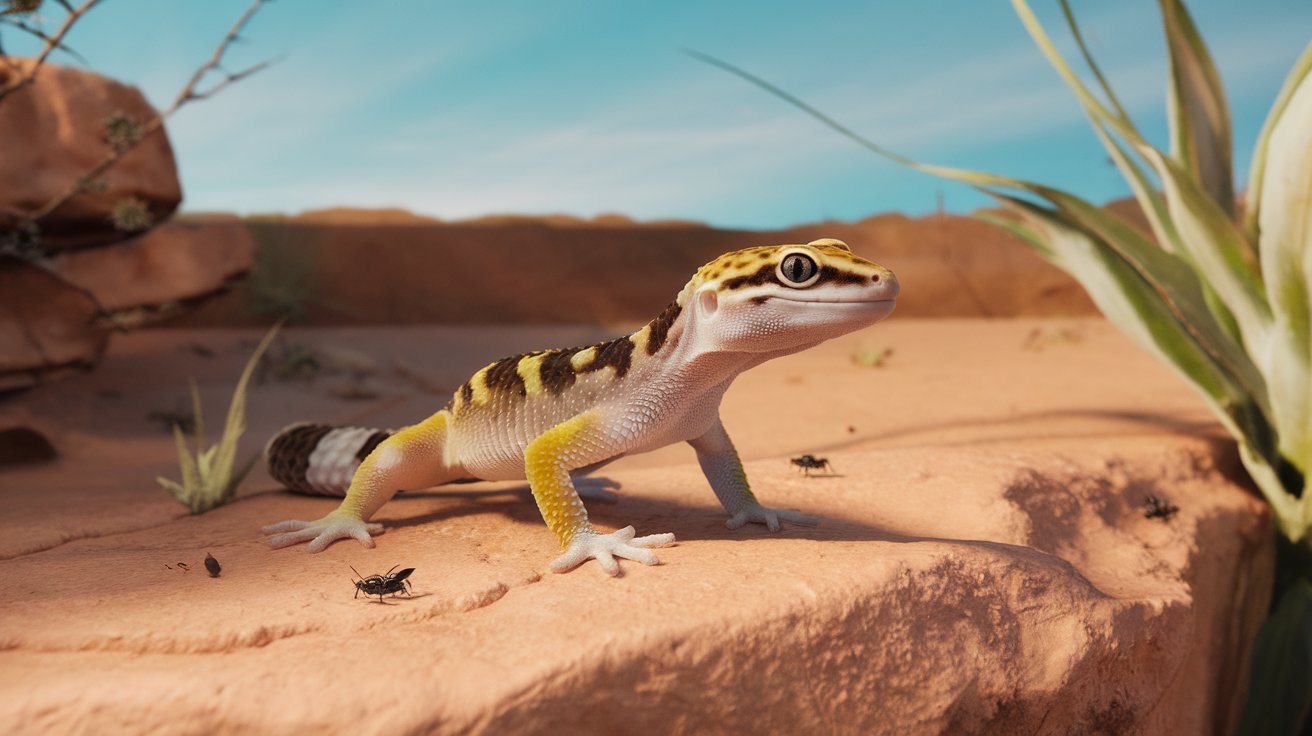Introduction
Creating the perfect habitat for your hermit crabs, known as a crabitat, is essential to ensure their health and happiness. Hermit crabs require specific conditions to thrive, including the right substrate, humidity, and access to both fresh water and salt water. A well-prepared crabitat includes a deep enough substrate for burrowing, an aquarium heater for maintaining the right temperature, and a properly monitored humidity level, which is crucial for their breathing. When setting up your hermit crab tank, it’s important to mimic their natural tropical environment, providing a secure and comfortable space for your pets to live.
From selecting marine-grade salt for their saltwater pools to ensuring your tank is at least 10 gallons per crab, there are key elements that make a difference in the quality of your crabitat. Hermit crabs love to climb and explore, so enriching their environment with items like shells, fake plants, and even a food dish enhances their experience. Following these tips will help you create a balanced, healthy, and enriching home for your hermit crabs.
Key Takeaways
- A deep enough substrate, like play sand or ecoearth, is crucial for hermit crabs to burrow comfortably and maintain humidity levels in their habitat.
- Maintaining humidity levels between 70% and 80% is essential for hermit crabs’ breathing, which can be achieved using a hygrometer, misting, and sponges.
- Hermit crabs need access to both freshwater and saltwater pools to stay hydrated and support their molting process.
- Properly preparing saltwater with marine-grade salt is necessary to ensure your crabs’ health and avoid harmful chemicals.
- Creating a secure and comfortable cage with climbing structures and a stable temperature is key for hermit crabs’ physical and mental stimulation.
- Using a tank heater or overhead lights to maintain a tropical environment between 75°F and 85°F helps hermit crabs thrive, especially during nighttime.
Choosing the Right Substrate for Your Hermit Crab Habitat
Selecting the proper substrate is essential for creating a healthy hermit crab habitat. Hermit crabs need a deep enough substrate, such as play sand or ecoearth, to burrow comfortably, especially during molting. The substrate should retain moisture, which helps maintain the required humidity levels inside the tank. Crab owners often mix substrates like play sand with coconut fiber to ensure stability and comfort for the crabs. The depth of the substrate should be at least 6 inches per crab to allow for proper burrowing, which is a natural behavior for these fascinating creatures. Ensuring the right substrate is key to keeping hermit crabs happy and healthy.
Best Substrates for a Healthy Hermit Crab Habitat
1. Play Sand for Natural Burrowing
Play sand is one of the most popular choices for hermit crab owners because it closely mimics the natural environment of hermit crabs. The fine grains make it easy for them to burrow and create tunnels, especially during molting. Play sand also holds moisture well, which helps maintain the necessary humidity levels within the tank. Ensuring the substrate is deep enough—at least 6 inches—will allow your hermit crabs to feel secure and comfortable while they dig and hide.
2. Ecoearth for Moisture Retention
Ecoearth, a type of coconut fiber substrate, is excellent for retaining moisture, which is essential for keeping your hermit crabs’ habitat at the right humidity levels. This substrate helps in keeping the air moist, which hermit crabs need for breathing through their modified gills. Additionally, ecoearth is a soft and natural material that crabs enjoy burrowing into. Combining it with play sand can create a perfect balance of structure and moisture in your crabitat.
3. Mixture of Play Sand and Coconut Fiber
Using a combination of play sand and coconut fiber (ecoearth) offers the best of both worlds. The sand provides stability for burrowing, while the coconut fiber holds moisture well. This balanced mix helps ensure your hermit crab habitat stays both dry enough for structure and moist enough for breathing comfort. It also prevents the substrate from becoming too compact or too loose, creating a more natural and enriching environment for your crabs.
4. Aragonite Sand for Calcium Boost
Aragonite sand, made from crushed coral, not only serves as a great burrowing material but also provides a calcium source for hermit crabs. As hermit crabs molt, calcium is vital for rebuilding their exoskeletons. Using aragonite sand as part of the substrate can help supplement your hermit crabs’ diet naturally. While it is slightly pricier than other options, it offers added health benefits that can contribute to your crabs’ overall well-being.
5. Avoid Gravel or Pebbles
While gravel or pebbles might seem like a convenient substrate, they are not suitable for hermit crabs. These materials do not hold moisture well and can be too rough for crabs to burrow in. Hermit crabs need a soft, fine-grain substrate that they can dig into easily, especially during molting periods. Using gravel can cause stress and discomfort, so it’s best to stick to softer options like play sand or coconut fiber.
Why Deep Substrate is Essential for Hermit Crabs
Hermit crabs require deep substrate to mimic the burrowing behavior they exhibit in the wild, particularly during molting. A substrate depth of at least 6 inches per crab is ideal to allow them to dig down and feel secure. Play sand mixed with ecoearth provides a soft yet sturdy environment that crabs love to explore and dig through. The deeper the substrate, the more natural their habitat becomes, ensuring that their molting and burrowing needs are met, promoting long-term health and comfort for your hermit crabs.
Best Substrate Mix for a Balanced Habitat
The right combination of substrates can provide both comfort and functionality. Hermit crab owners often use a mix of play sand and coconut fiber for its ability to retain moisture and support proper humidity levels. This mixture is easy for crabs to move through and creates a stable base in their habitat. It’s important to monitor the substrate’s moisture content, as keeping it too dry can make burrowing difficult, while too much water can lead to bacterial growth or mold, affecting the crabs’ health.
Maintaining Proper Humidity in Your Hermit Crab Habitat
Hermit crabs require a carefully controlled humidity level to thrive, as they breathe through modified gills that need moisture in the air. The relative humidity inside the hermit crab habitat should ideally stay between 70% and 80%. A hygrometer is essential for monitoring this. You can use plastic wrap to cover part of the tank to maintain humidity, and misting the habitat with freshwater also helps. Crab owners often place sponges in the enclosure to help retain moisture. Without the right humidity, hermit crabs can have difficulty breathing, which may lead to health problems.
Case Study: Maintaining Humidity for a Hermit Crab Habitat
In 2020, a hermit crab owner from Texas documented her journey of successfully maintaining the proper humidity levels in her crabitat during the dry winter months. Her initial setup included a hygrometer that frequently showed humidity levels dropping below the ideal 70%, which caused her crabs to become sluggish and less active. After consulting with experienced hermit crab owners online, she learned the importance of adding natural moss and using sponges soaked in distilled water to maintain humidity.
She also covered part of the tank with plastic wrap to trap moisture, which significantly improved the humidity levels. The hygrometer readings consistently showed between 70% and 80% humidity after these adjustments, leading to more active and healthier crabs. Additionally, misting the habitat with freshwater a few times a day played a key role in sustaining the environment, ensuring the crabs could breathe comfortably through their modified gills.
How to Monitor and Adjust Humidity Levels
Keeping a close eye on humidity levels is essential to maintain a thriving hermit crab habitat. Using a hygrometer, you can ensure the habitat stays within the optimal range of 70-80% humidity. Adding moss or using sponges soaked in water can help raise humidity levels naturally. If humidity drops too low, it can cause stress for the crabs and lead to dehydration. Plastic wrap covering parts of the tank can also help maintain a stable environment, especially in dry climates or during the colder months when humidity tends to decrease.
The Role of Freshwater in Maintaining Humidity
Freshwater is essential in keeping the humidity levels within the hermit crab’s habitat balanced. Mist the habitat regularly with freshwater to create the moist air that hermit crabs require for their gill function. Crab owners often place shallow water dishes around the tank, ensuring the water doesn’t evaporate too quickly. The freshwater not only maintains humidity but also provides hydration for the crabs. Using distilled or dechlorinated water will prevent any chemical exposure that can harm your hermit crabs.
The Importance of Salt Water in a Hermit Crab’s Cage
Providing salt water in your hermit crab’s cage is crucial, as hermit crabs require both fresh and saltwater pools for their hydration and molting processes. Use marine-grade salt to prepare the water, ensuring it’s free of chlorine and other harmful chemicals. These pools should be deep enough for the crabs to submerge partially, but easy for them to climb out of to avoid drowning. You can purchase marine-grade salt from a pet store or make your own mix at home. Hermit crabs need access to both freshwater and saltwater to maintain their internal salt balance.
How to Safely Prepare Salt Water for Hermit Crabs
When preparing salt water for your hermit crabs, it’s crucial to use marine-grade salt mixes, as table salt contains additives that can harm your crabs. Simply mix the salt with distilled or dechlorinated water to create a safe environment. The saltwater pool should be shallow enough for smaller crabs to access but still large enough for larger crabs to submerge when needed. Crabs love to use these pools to regulate their internal salt balance, which is key to their hydration and overall health.
Balancing Freshwater and Saltwater Pools
Hermit crabs need access to both saltwater and freshwater pools inside their habitat. Both pools should be placed in a way that is easy for crabs to find, with shallow edges to allow for safe climbing in and out. Use natural sea salt to create the saltwater pool, and distilled water for the freshwater one. Monitoring the water quality regularly ensures there is no build-up of ammonia or harmful bacteria, keeping the crabs’ environment clean and healthy.
“Water is the driving force of all nature.” – Leonardo da Vinci
Creating a Secure and Comfortable Cage for Your Hermit Crabs
A hermit crab’s cage needs to provide both security and comfort to mimic their natural tropical environment. A glass tank works well, as it helps maintain stable temperatures and humidity. Adding things for the crabs to climb, such as fake plants and moss, enriches the space and keeps them active. The enclosure should have a cycle of light and dark to simulate natural day and nighttime conditions. Use a tank heater or overhead lights to regulate the temperature, ensuring it remains between 75°F and 85°F. Sealing the tank lid with plastic wrap can also help keep the humidity stable.
Temperature Control Inside the Hermit Crab Cage
Maintaining the right temperature inside the cage is essential for your hermit crabs’ well-being. Crabs thrive in a tropical environment, which means their cage should be kept at a temperature between 75°F and 85°F. Using a thermostat to regulate a tank heater or an overhead light can help you monitor and control temperature. Hermit crabs are nocturnal creatures, so providing a gentle heat source during the nighttime can prevent any sharp drops in temperature that could stress your crabs.
Enrichment and Climbing Features for Hermit Crabs
Crabs love to climb and explore, so enriching their environment with climbing structures can make their cage feel more like their natural habitat. Adding fake plants, moss, or even river stones along the sides of the tank will encourage activity and exercise. Hermit crabs are social creatures, and providing an engaging space with things to climb and explore will prevent boredom and promote better overall health. Crabs need these features to stay mentally and physically stimulated inside their enclosure.
Conclusion
Creating the perfect crabitat for your hermit crabs isn’t just about putting them in a tank. It’s about making sure they have everything they need to live happily, from maintaining the right temperature to giving them proper humidity. Using a heat pad or light bulbs during the daytime will help keep the tank between 75°F and 85°F, which is the sweet spot for hermit crabs. Whether you’re housing marine hermit crabs or small crabs, they thrive when their space feels like their natural tropical environment. Adding climbing structures and keeping water pools fresh is essential to their happiness.
You’ll also want to make sure the tank is sealed properly to keep the environment stable. Hermit crabs need access to both freshwater and saltwater pools made with marine-grade salt to stay hydrated and molt, which is important for their exoskeleton. Don’t forget to monitor the temperature with a thermometer and use a UTH to keep the humidity high. Following these steps will make sure your hermit crabs stay healthy and stress-free in their new home!

